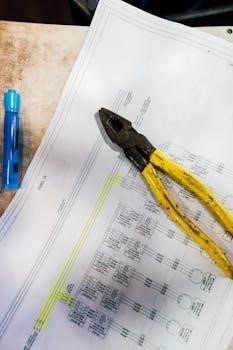GE Appliances Reverse Osmosis systems are designed for filtering potable water in residential settings. These systems are installed at the point of use, ensuring purified water. It uses semi-permeable membranes and filter replacements are critical for performance. The system requires a battery for timer reset.
Overview of GE Reverse Osmosis Technology
GE Reverse Osmosis (RO) technology employs a semi-permeable membrane to purify water by forcing it through, effectively removing impurities. This process ensures that the water is significantly cleaner than standard tap water. The system is engineered for residential use, focusing on improving the quality of potable water. GE’s RO systems are designed to be user-friendly, typically installed at the point of use for convenience. Regular maintenance, including filter replacements indicated by an amber light, is essential to maintain its optimal performance. The technology aims to provide a reliable and efficient method for water purification, enhancing the safety and taste of water in households. The system’s effectiveness hinges on the proper functioning of the membrane and associated filters. Proper battery maintenance is crucial to ensure that the timer works correctly.

Installation and Setup
GE RO systems require specific pre-installation checks before setup. The system must be installed at the point of use. Follow the step-by-step guide carefully for correct installation. Proper setup ensures the system functions effectively and provides clean water.
Pre-Installation Requirements
Before installing your GE Reverse Osmosis system, several crucial pre-installation requirements must be met to ensure proper functionality and prevent potential issues. Firstly, verify that the system is intended for residential use with potable water; it’s not designed for other applications. The installation point must be at the point of use, typically under the kitchen sink. Ensure you have adequate space for the system and its components, and that the plumbing connections are compatible. Check the water pressure and temperature to ensure they fall within the specified operating ranges for optimal performance. Confirm that you have all necessary tools and materials to complete the installation process, following the GE manual and any instructions carefully. It is also essential to review the system’s specifications and requirements, as outlined in the user manual, to prevent any errors during the initial setup. Inspect that all components are included and in good condition.
Step-by-Step Installation Guide
The installation of your GE Reverse Osmosis system requires careful adherence to the manufacturer’s instructions. Begin by shutting off the main water supply to prevent any leaks. Next, connect the feed water adapter to the cold water line and then attach the RO system to the adapter using the provided tubing. Secure the drain line connection to the sink drain, ensuring a tight seal. Install the faucet on the countertop and connect it to the RO system. Mount the RO unit securely under the sink, being mindful of space and accessibility for future maintenance. Insert the filters into their respective housings, and then connect the storage tank. Check all connections for any leaks before turning on the water supply. Finally, refer to the manual for specific instructions about the initial system flushing and testing procedure before use.

Operation of GE RO Systems
GE RO systems purify water by forcing it through a semi-permeable membrane. Regular operation involves monitoring the amber light, which signals when filters need replacement. Proper maintenance keeps the system functioning effectively and reliably.
Understanding the Filtration Process
GE Reverse Osmosis (RO) systems employ a sophisticated filtration method to purify water. The core of this process involves forcing water under pressure through a semi-permeable membrane. This membrane acts as a very fine filter, effectively blocking the passage of many contaminants, including minerals, salts, and other impurities; Water molecules are able to pass through the membrane, while larger particles are rejected. This results in cleaner, purer water on the other side. The RO process is highly efficient at removing a wide array of contaminants, ensuring that the water is safe for consumption. The process is continuous, with water constantly being filtered. Understanding the filtration process helps in appreciating the importance of regular maintenance, such as filter replacement, to maintain the system’s effectiveness.
Normal Operation and Maintenance
During normal operation, GE RO systems continuously purify water as needed. The system should function quietly and efficiently, providing a steady supply of filtered water. It’s important to note that the system typically runs at the point of use. Regular maintenance is crucial for optimal performance and longevity. This includes monitoring the system for any unusual noises or leaks. Filter replacement is a vital part of maintenance, and should be done when the amber light begins to flash. This is essential to protect the RO membrane and maintain the quality of purified water. Simultaneously, the battery should be replaced to reset the system timer. Proper maintenance ensures the system consistently delivers high-quality water.

Maintenance and Troubleshooting
Maintaining your GE RO system involves filter changes when the amber light flashes, and replacing the battery to reset the timer. Troubleshooting includes addressing common issues and following proper sanitization procedures, ensuring its effective and safe operation.
Filter Replacement Procedures
Maintaining your GE Reverse Osmosis system requires timely filter replacements to ensure optimal performance and water purity. The system typically indicates when filter replacement is needed; often, an amber light will begin to flash. This signal is critical as neglecting filter changes can compromise the RO membrane’s effectiveness. When replacing the filters, it is essential to use genuine GE replacement filters to maintain system integrity. Simultaneously with filter replacement, the battery should be removed and replaced to reset the timer, which will allow the system to accurately track filter usage. Always follow the specific steps outlined in your GE RO system’s manual for a successful filter replacement, ensuring proper installation and preventing any leaks. Regularly scheduled filter replacements are not just a maintenance task but a key factor in extending the life of your system and guaranteeing the consistent delivery of high-quality purified water.
Troubleshooting Common Issues
When operating a GE RO system, you might encounter some common issues. If the system is not producing purified water, check if the filters need replacement, as indicated by the flashing amber light. Low water pressure can also affect the system’s performance. Ensure that the water supply valve is fully open and that there are no blockages in the water lines. Unusual noises during operation may indicate that a component is loose or needs attention. Inspect the system for any visible leaks and tighten connections if needed. If the system continues to malfunction, consider replacing the battery to reset the timer. Refer to the owner’s manual for specific troubleshooting steps and diagrams. Addressing these common issues promptly will help keep your system operating smoothly and efficiently. Remember, regular maintenance and filter replacements are crucial in preventing these issues.
Sanitization Procedures
Maintaining the hygiene of your GE RO system is critical for optimal performance and water safety. Regular sanitization prevents bacterial growth and ensures that the filtered water remains pure. The sanitization process involves several steps, beginning with turning off the water supply to the system. Next, disconnect the water lines and remove all the filters. Prepare a sanitizing solution, following the manufacturer’s guidelines, typically using a mild bleach solution. Introduce this solution into the system, ensuring that it reaches all components. Let it sit for the recommended time, usually around 15-20 minutes. After sanitization, thoroughly flush the system with clean water until no traces of the sanitizing solution remain. Reinstall the filters and reconnect the water lines. Sanitizing your RO system regularly keeps it free from bacteria and provides clean, safe water; Refer to the user manual for specific guidelines.

Safety and Support
Always adhere to safety precautions outlined in the manual. For support, consult the provided documentation, appliance manuals, or online resources. Ensure proper handling to maintain system functionality. The user manual provides essential guidance.
Safety Precautions
Prior to installation or maintenance of your GE Reverse Osmosis system, it is imperative to carefully review all safety guidelines outlined in the user manual. The system is specifically designed for residential use with potable water and has not been evaluated for other applications. Ensure the system is installed at the point of use as specified in the manual. When replacing filters, remember to also change the battery to reset the timer, and do not operate the system with flashing amber light. The system is designed to purify water by forcing it through a semi-permeable RO membrane. Always disconnect the power supply before performing any maintenance or filter replacements. Never attempt to modify the system, and when working with water, ensure the surrounding area is dry to prevent slipping hazards. Regularly inspect the system for any leaks or damage. If you identify any issues, refer to the troubleshooting section of the manual or contact customer support. Proper adherence to these guidelines will promote safe and efficient operation of the reverse osmosis system.
Accessing Support and Documentation
For comprehensive support and detailed information regarding your GE Reverse Osmosis system, several resources are readily available. The primary source of information is the owner’s manual, which provides specific guidance on installation, operation, and maintenance. Manuals for various GE RO models, such as GXRM10RBL, GXRQ18NBN, and GXRV40TBN, can be accessed online through the GE Appliances website or other online resources. These manuals often include step-by-step instructions, troubleshooting guides, and safety precautions. Additionally, many appliance manuals and free PDF instructions can be found on platforms like ManualsOnline. If further assistance is required, contact GE customer support through their official channels; You may also find support documentation on the GE Healthcare website. Ensure you have the model number of your system ready when seeking support. Furthermore, the system’s documentation includes details on the critical replaceable treatment components for effective water reduction. Utilizing these resources will help you manage your system and maintain optimal performance, addressing any questions you may have.